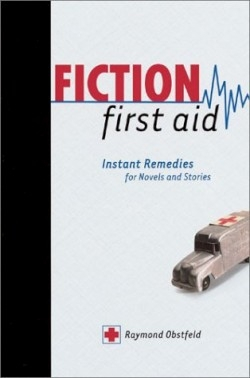Fiction First Aid
Underdescription and overdescription are the two most common mistakes
that writers make with setting, according to the author. These are symptoms of an ailment he calls “wallpaper settings.” In this book he gives diagnosis, treatments, and physical therapy exercises for these and other common ailments faced by writers of both short and long fiction.
Underdescription creates a “bland wallpaper” effect that doesn’t contribute to the story because the reader is unable to visualize the surroundings. Overdescription causes a “gaudy wallpaper” effect, giving the reader a feeling that he’s at a too-crowded party. “Every time you approach the protagonists to hear what they’re saying,” Obstfeld explains, “another stranger intercepts you to engage in annoying conversation about the history of this chair, or how vivid the colors are in this painting, or how the clouds outside resemble the Beatles, with that fifth cloud off by itself giving off the sad, isolated look of Pete Best…”
To treat these ailments the writer must determine what role environment will play in the story. Is it meant to be a symbol of the characters’ inner struggle, as in Theroux’s Mosquito Coast, or a direct influence on their choices, as in Steinbeck’s The Grapes of Wrath? Sometimes a scene needs just enough setting to anchor it; other times the setting can be considered another character in the story.
Obstfeld suggests three exercises to treat wallpaper settings: describe the setting’s characteristics, list how it affects the characters, and list how it affects the plot. This can isolate the role of the setting in the writer’s mind and identify how much description it really needs.
Obstfeld, author of fifty novels, nonfiction books, and screenplays including The Novelist’s Essential Guide to Creating Scenes, is head of the writing program at Orange Coast College in Costa Mesa, California. His experience with his own and others’ writing problems led him to develop this first aid manual. Symptoms are indexed so the writer can look up his ailment and go straight to the fix. It covers many of the most common obstacles writers face and gives sound advice for correcting them now and avoiding them in the future. In addition to setting, the manual discusses ailments of plot, characterization, style, and theme. This book would prove a valuable resource to advanced creative writing classes, writer’s groups, or any writers who finds themselves stuck.
Reviewed by
Christine Canfield
Disclosure: This article is not an endorsement, but a review. The publisher of this book provided free copies of the book to have their book reviewed by a professional reviewer. No fee was paid by the publisher for this review. Foreword Reviews only recommends books that we love. Foreword Magazine, Inc. is disclosing this in accordance with the Federal Trade Commission’s 16 CFR, Part 255.

